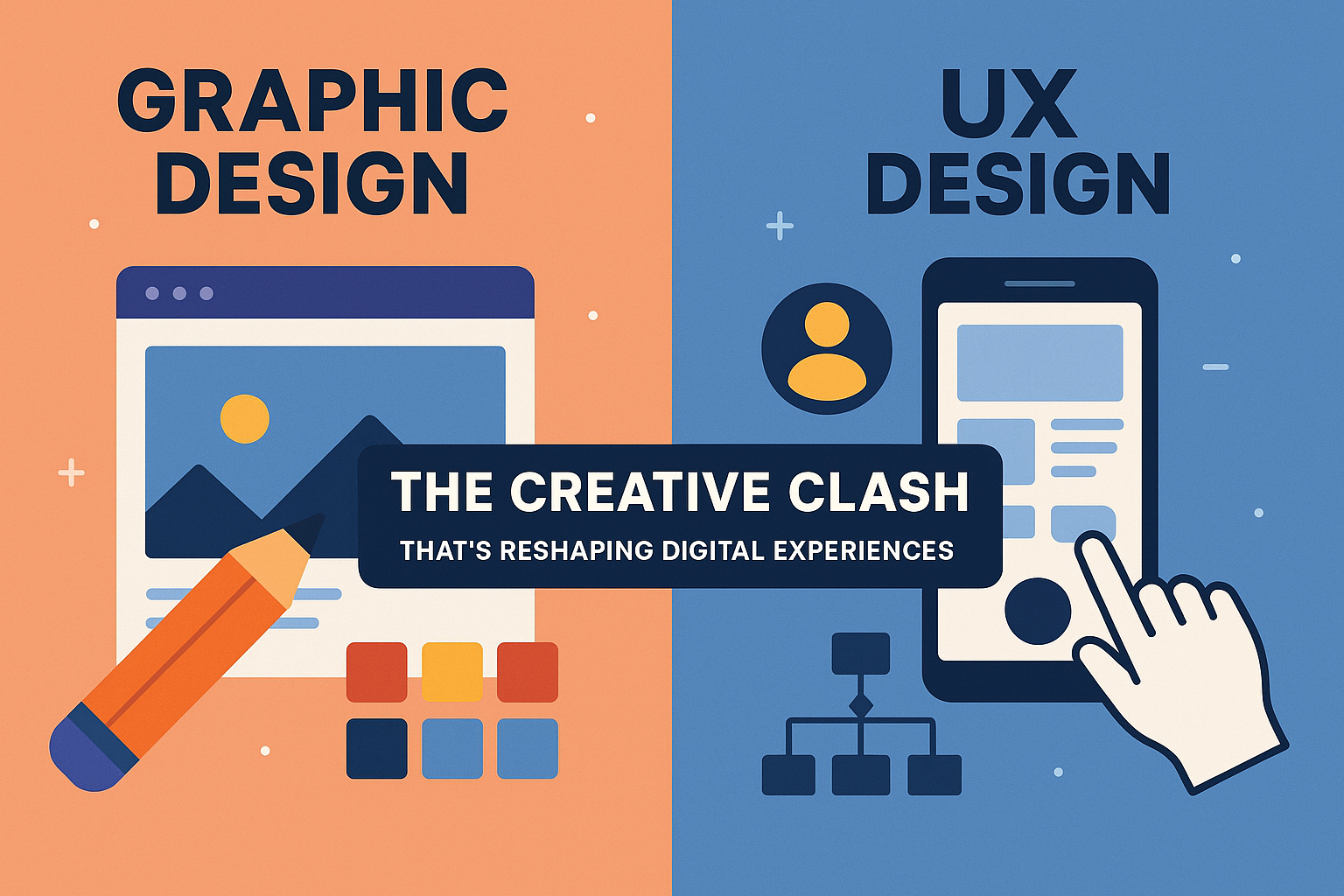The Great Design Divide 🤔
Walk into any design agency today, and you’ll likely witness an age-old debate: should we prioritize how something looks, or how it works? 💭
On one side, you have graphic designers crafting visually stunning interfaces that make users stop and stare. On the other, UX designers obsessing over user flows, testing every interaction until it’s frictionless. It’s a creative tension that’s been brewing for years, but here’s the thing – maybe we’ve been looking at this all wrong.
Understanding the Players
Graphic Design: The Visual Storytellers 🎨
Graphic designers are masters of visual communication. They transform abstract ideas into compelling visuals that grab attention and convey meaning instantly. Their focus? Creating memorable brand experiences through thoughtful use of color, typography, imagery, and layout.
Think about apps like Blinkit with their vibrant yellow branding and bold visual identity 🟡. Their design choices aren’t random – that bright yellow communicates speed and energy, perfectly aligning with their quick delivery promise.
They even design special paper bags for different occasions – Diwali bags with traditional motifs, cricket-themed designs during matches, or Valentine’s Day patterns. Each seasonal design keeps the brand fresh while maintaining that recognizable yellow identity.
Or consider Netflix’s sleek dark interface that makes content pop ✨. These aren’t just pretty pictures – they’re strategic visual decisions that build emotional connections with users.
Core focus areas:
- Visual hierarchy and composition
- Brand consistency across touchpoints
- Emotional impact through design elements
- Print and digital asset creation
UX Design: The Experience Architects 🏗️
UX designers take a different approach. They’re constantly asking: “How can we make this easier for the user?” Their work involves deep research into user behavior, creating intuitive navigation paths, and ensuring every interaction serves a purpose.
Consider how effortlessly you navigate apps like Spotify 🎵 or book a ride on Uber 🚗. That seamless experience doesn’t happen by accident – it’s the result of careful UX planning and testing.
Core focus areas:
- User research and behavioral analysis
- Information architecture and user flows
- Usability testing and iteration
- Problem-solving through design
Where the Tension Lives
The friction between these disciplines often centers on competing priorities:
Graphic designers might push for a bold, unconventional layout that makes a strong visual statement, while UX designers advocate for familiar patterns that users can navigate intuitively.
UX designers might simplify an interface to improve usability, while graphic designers worry it lacks visual interest or brand personality.
This tension isn’t necessarily bad – it often leads to better solutions. But when these teams work in silos, the results can be problematic: gorgeous websites that frustrate users, or highly functional apps that lack any emotional appeal.
The Collaboration Sweet Spot
The most successful digital products happen when graphic and UX design work in harmony. Take Airbnb’s platform – it looks inspiring enough to make you want to travel ✨, and it works so smoothly that booking a stay feels effortless ⚡.
What effective collaboration looks like:
Shared understanding: Both teams align on user goals and business objectives from the start
Complementary skills: Graphic designers bring visual polish to UX wireframes, while UX designers ensure beautiful designs actually work for users
Iterative process: Regular feedback loops where both perspectives inform design decisions
User-centered focus: Visual decisions are tested for usability, while functional decisions consider emotional impact
Beyond the False Choice
Perhaps it’s time to retire the “form vs. function” debate entirely. Today’s users expect both – they want products that look great AND work flawlessly. The companies winning in the marketplace understand this.
The most innovative design solutions emerge when teams reject the false choice between aesthetics and usability. Instead, they ask better questions: How can visual design enhance usability? How can user research inform visual decisions? How can we create experiences that are both beautiful and functional?
The Bottom Line
The clash between graphic design and UX design has driven innovation for years, but the future belongs to teams that see these disciplines as complementary rather than competing forces.
Whether you’re building a startup’s first app or redesigning an enterprise platform, the question isn’t whether to prioritize visual impact or user experience – it’s how to achieve both simultaneously.
Great design doesn’t ask users to choose between beauty and functionality. It delivers both seamlessly, creating experiences that users not only accomplish their goals with, but genuinely enjoy using.
What’s been your experience working across graphic and UX design disciplines? Have you seen successful collaborations that delivered both visual impact and great usability?
Share your thoughts on the future of graphic and UX design collaboration by checking out our latest LinkedIn post.
Also, don’t miss our previous article: Boost User Engagement with Lottie & Dynamic Icons

Leave a Reply
You must be logged in to post a comment.